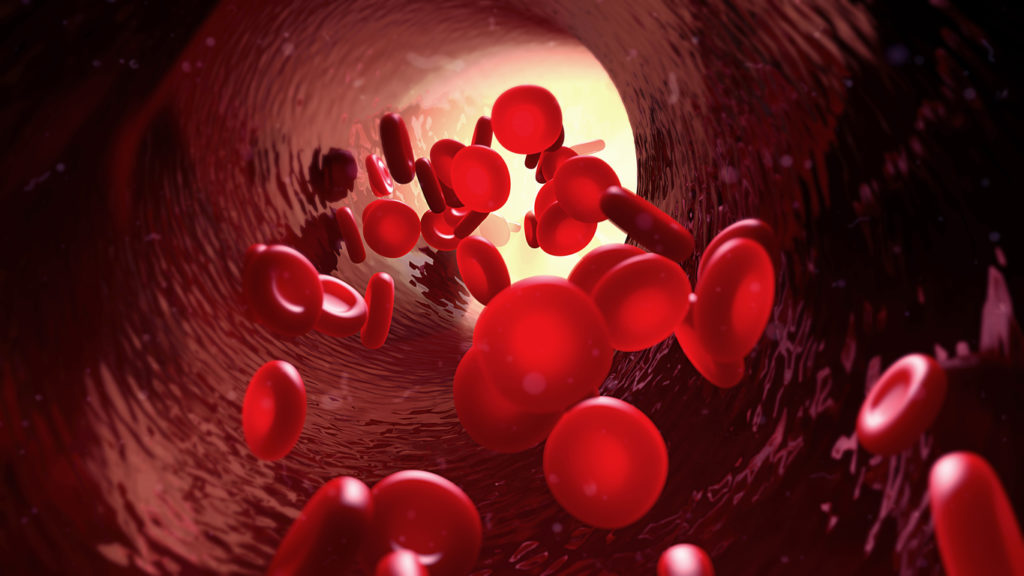Patients with sickle cell disease have abnormal hemoglobin (the protein in red blood cells that carries oxygen to the body). This abnormality causes red blood cells to take on a sickle shape, producing disease symptoms. Fetal hemoglobin, a type of hemoglobin present in fetuses and babies, can prevent red cells from sickling. The drug hydroxyurea increases fetal hemoglobin production in patients with sickle cell disease by making a molecule called nitric oxide. The drugs L-arginine and Sildenafil (Viagra) increase the amount or the effect of nitric oxide. This study will evaluate:
Patients with sickle cell disease have abnormal hemoglobin (the protein in red blood cells that carries oxygen to the body). This abnormality causes red blood cells to take on a sickle shape, producing disease symptoms. Fetal hemoglobin, a type of hemoglobin present in fetuses and babies, can prevent red cells from sickling. The drug hydroxyurea increases fetal hemoglobin production in patients with sickle cell disease by making a molecule called nitric oxide. The drugs L-arginine and Sildenafil (Viagra) increase the amount or the effect of nitric oxide. This study will evaluate: – The safety of giving L-arginine or Sildenafil together with hydroxyurea in patients with sickle cell disease;- The effectiveness of L-arginine plus hydroxyurea or Sildenafil plus hydroxyurea in increasing fetal hemoglobin in patients with sickle cell disease; and – The effectiveness of L-arginine plus hydroxyurea or Sildenafil and hydroxyurea in lowering blood pressure in the lungs of patients with sickle cell disease. (Pulmonary blood pressure is elevated in about one-third of patients with sickle cell disease, and this condition increases the risk of dying from the disease.) Patients with hemoglobin S-only, S-beta-thalassemia, or other sickle cell disease genotype may be eligible for this study.Before starting treatment, patients will have a complete medical history and physical examination. All patients will take hydroxyurea once a day every day by mouth for at least 2 months. They will be admitted to the NIH Clinical Center to take their first dose of hydroxyurea, and will have blood drawn through a catheter (plastic tube placed in a vein) every hour for 6 hours for tests to determine nitric oxide levels. After discharge, they will return to the clinic once every 2 weeks to check for treatment side effects and for blood tests to monitor hemoglobin and fetal hemoglobin levels. After fetal hemoglobin levels have been stable for 2 months, patients will be admitted to the Clinical Center for their first dose of L-arginine (for men) or Sildenafil (for women). Again, blood samples will be collected through a catheter once an hour for 6 hours. If there are no complications, patients will be discharged and will continue taking hydroxyurea once a day and L-arginine or Sildenafil three times a day for at least 3 months until fetal hemoglobin levels have been stable for at least 2 months. Patients will return to the clinic for blood tests every week for 2 weeks and then every 2 weeks to monitor hemoglobin and fetal hemoglobin levels and to check for treatment side effects. Patients will have eye examinations before and during treatment. Some patients with sickle cell disease develop abnormalities in the blood vessels of the eye. Also, Sildenafil can cause temporary changes in color vision. Rarely, more serious eye problems can occur, such as bleeding from the eye blood vessels or damage to the retina-a layer of tissue that lines the back of the eye. Patients will also have an echocardiogram (ultrasound of the heart) before beginning treatment, after hydroxyurea treatment, and after 1 and 3 months of combined treatment with hydroxyurea and L-arginine or Sildenafil to help measure blood pressure in the lungs. Patients who develop complications from L-arginine or Sildenafil may continue in the study on hydroxyurea alone. Patients whose fetal hemoglobin levels increase with the combination therapy of hydroxyurea and L-arginine or Sildenafil may continue to take them. Condition: – Sickle Cell Anemia Study Type: InterventionalStudy Design: Treatment, Safety Official Title: Evaluation of Potential Synergy of Combining Hydroxyurea with Nitric Oxide Donors on Fetal Hemoglobin Synthesis in Patients with Sickle Cell Anemia Further Study Details: Hydroxurea is a cell-cycle specific agent that blocks DNA synthesis by inhibiting ribonucleotide reductase, the enzyme that converts ribonucleotides to deoxyribonucleotides. Hydroxyurea has been shown to induce the production of fetal hemoglobin (HbF), initially in non-human primates, and now in patients with sickle cell anemia. The majority of patients with sickle cell disease respond to the drug with a more than two-fold increase in HbF levels; in some patients the percent of HbF exceeds 10 or 15 percent. It is estimated that levels of 20 percent are required to substantially reduce the sickling propensity of red cells and to modulate disease severity. We have recently found that hydroxyurea therapy is associated with the intravascular and intraerythrocytic generation of nitric oxide (NO), and that NO accounts for HbF induction via the guanylyl cyclase/cGMP dependent pathways. In fact, NO donors such as S-nitroso-cysteine and NONOates similarly induce HbF expression in human erythropoietin treated human CD 34+ stem cells. Possible synergy between NO donor therapy and classic cytostatic and differentiating medications should be explored. We propose to treat several patients chronically with hydroxyurea to determine hematological changes longitudinally. Once a maximal Hb-F raising effect of hydroxyurea has been established, oral L-arginine (the substrate for NO synthase) and sildenafil (Viagra, a phosphodiesterase inhibitor that potentates cGMP dependent signaling) will be added to determine the ability of other agents to enhance HbF synthesis, especially in hydroxyurea non-responders or partial-responders. Additionally, we have found that up to 33% of patients with sickle cell disease also have secondary pulmonary hypertension, measured by echocardiogram. A secondary endpoint of this study will be to evaluate if chronic hydroxyurea therapy and the addition of L-arginine or sildenafil will improve the pulmonary hypertension in this subgroup. Eligibility Genders Eligible for Study: Both Accepts Healthy VolunteersCriteria INCLUSION CRITERIA:A total of 50 patients with homozygous sickle cell disease or other sickling disorders (e.g., B(0) or B(+) Thalassemia/Sickle) whom are greater than 15 years of age will be eligible for treatment.Patients currently being followed on an NIH study or at Howard University on stable doses of hydroxyurea are also eligible.Patients must have documented hemoglobin S-only, S-beta-thalassemia, or other sickle cell disease genotype. Only patients with hemoglobin S-only will be considered in the primary analysis.Patients must have relatively well preserved renal and hepatic function (creatinine less than 1.6 mg/dl and normal liver function test less than 5 X normal ALT).Evidence of severe sickle cell anemia will include one or more of the following: recurrent pain crisis (greater than or equal to 2 ER visits per year), recurrent acute chest syndrome (a lung problem like pneumonia), hospitalizations, leg ulceration, priapism, aseptic necrosis of the hip, and/or pulmonary hypertension.Patients must be able to provide informed consent.EXCLUSION CRITERIA:Patients who have hemoglobin S and A (trait) or hemoglobin A-only (non-sickle cell).Patients must not be on a chronic transfusion program, defined as regular transfusions every 2-8 weeks.Patients who are found to be HIV positive will be excluded from the study.Patients must not be pregnant or breast feeding.Patients on chronic nitrates, such as nitroglycerin.Expected Total Enrollment: 50 [1] Warren G. Magnuson Clinical Center (CC), 9000 Rockville Pike, Bethesda, Maryland (US)
All content and media on the HealthEngine Blog is created and published online for informational purposes only. It is not intended to be a substitute for professional medical advice and should not be relied on as health or personal advice. Always seek the guidance of your doctor or other qualified health professional with any questions you may have regarding your health or a medical condition. Never disregard the advice of a medical professional, or delay in seeking it because of something you have read on this Website. If you think you may have a medical emergency, call your doctor, go to the nearest hospital emergency department, or call the emergency services immediately.







